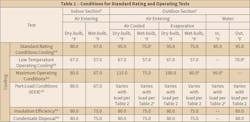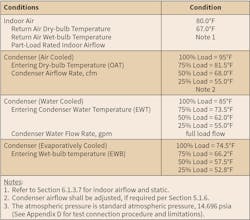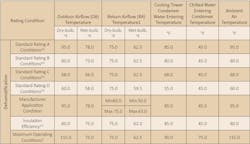Understanding AHRI 920 and ISMRE Ratings for Most Efficient DOAS Specification
By JOHN McKISSACK, P.E., Nortek Global HVAC, St. Louis, MO
Dedicated outdoor air systems (DOAS) have become a staple of HVAC specifications over the last 20 years. However, the absence of a test standard, certification program, and an efficiency rating target makes it near impossible for engineers and contractors to compare brands, models, and features.
The industry has for years compared packaged unit efficiency utilizing AHRI Standard 340/360, Performance Rating of Commercial and Industrial Unitary Air-Conditioning and Heat Pump Equipment. In addition, the minimum efficiency has been well established by ASHRAE Standard 90.1, Energy Standard for Buildings, Except Low-Rise Residential Buildings. This conjures several questions:
- Can AHRI 340/360 and its Integrated Energy Efficiency Ratio (IEER) work for DOAS units?
- Has ASHRAE 90.1 set a minimum efficiency level?
- What should consulting engineers use to compare DOAS products?
Thanks to AHRI 920 Performance Rating of DX Dedicated Outdoor Air System Units, these complex questions are now being addressed.
AHRI’s forthcoming standard 920-2018 due out later this year, continues the process for certified DOAS testing and establishes a clearer definition of efficiency ratings.
- For more on DOAS use in high-performance buildings, click here.
The current standard AHRI 920-2015 laid the groundwork. And, ASHRAE 90.1–2016 sets minimum efficiencies for DOAS product. An AHRI DOAS certification program is expected to be ratified sometime in the next two years, according to Ned Bent, associate certification engineer, AHRI. The certification program will help the U.S. Department of Energy (DOE) regulate DOAS via ASHRAE 90.1’s minimum efficiency requirements.
Why AHRI 340/360 Should Not Be Used For DOAS Specs
Unfortunately, we use AHRI 340/360 instead of AHRI 920 for DOAS calculations, according to Bent, who added that such a practice could possibly leave their DOAS ratings below the existing federal minimum efficiency requirements.
Comparing AHRI 340/360 and its IEER rating to AHRI 920’s Integrated Seasonal Moisture Removal Efficiency (ISMRE) rating clearly illustrates the former’s shortcomings for rating DOAS.
For example, looking at AHRI 340/360 Tables 1 and 2, how do the IEER rating points apply to an air-cooled DOAS unit conditioning 100-percent outdoor air?
Let’s examine the conditions. For IEER, the air quality of 80°F/67°F dry bulb/wet bulb for the evaporator coil is a reasonable and even an expected condition for outdoor air equipment. However, the associated condenser air temperature of 95°F at 100-percent load doesn’t seem possible. Since it’s 100-percent outside air, therefore, the evaporator and condenser air qualities should generally be the same. Similarly, a 65°F ambient condenser temperature at the 25-percent load and 80°F/67°F on the evaporator coil also seems like an impossible condition. So, it doesn’t make sense to test, rate, and optimize DOAS equipment in conditions that will never exist.
DOAS product without energy recovery also tends to use 200-cfm or less per ton of compression which is just another indicator that the type of loads is radically different than standard space condition units. IEER test conditions and efficiency targets optimize the design of equipment for space condition applications and not DOAS applications. Therefore, IEER is not an ideal metric for the DOAS product.
AHRI 920 has drastically different test conditions that are more appropriate for DOAS applications (See Table 3). And the metric is also radically different. AHRI 920 focuses primarily on the water removal and the amount of power required to reach a leaving dew point condition of less than 55°F.
Although ASHRAE 90.1-2016 now accepts AHRI 920, most local code jurisdictions still lag behind and accept earlier versions, such as ASHRAE 90.1-2010 or 90.1-2012 as their governing code. However, engineers in a state or local jurisdiction accepting any version should know that ISMRE efficiency ratings are part of ASHRAE 90.1-2016 for future specifications, which will probably affect them in approximately two years or more. In other words, an engineer that knows where a code is headed should design for it now, then manage a particular project for its specific needs.
The Emergence of ISMRE
Previously, engineers have depended upon Energy Efficiency Ratio (EER), Co-efficient of Performance (COP), and IEER to help select equipment. An ISMRE efficiency rating, as outlined in AHRI 920, is more appropriate than these rating systems, which were created for space air conditioning, not DOAS performance. ISMRE focuses on dehumidification while IEER focuses on capacity.
ISMRE is a better efficiency rating method for dehumidifying outdoor air. This rating will help drive the best green energy usage for DOAS in the future.
A simple explanation for a basic DOAS unit without energy recovery is in Table 4.
- Test Conditions: Test condition temperature conditions and their associated weight are a given per the standards;
- Weight: ISMRE is a numerical average per the given percentage “weights” for each test condition;
- Unit CFM: Unlike standard 340/360, the unit-rated CFM is determined by the manufacturer’s recommended operational points per their instructional manual. The airflow is a critical component in determining the load. Therefore when looking at ISMRE values, CFM values of like units can be compared;
- Evaporator Coil LAT: The leaving air temperature from the coil must be below 55°F dew point. Assuming a saturated coil, the chart shows dry bulb leaving air condition that is very close to dew point. Notice that the LAT can vary based upon normal unit operation. Therefore when comparing ISMRE values, also compare leaving air dew points. Some DOAS equipment may serve areas requiring 46°F dew points while others may serve spaces requiring 55°F dew points. But, both pieces of equipment may have similar ISMRE values;
- DX Capacity: This value is shown for informational purposes only;
- Unit EER: EER is shown in the table for informational purposes only. Engineers will have a tendency to make a direct correlation between EER and MRE. Because MRE values do not have consistent leaving air conditions, capacities, etc, a generalized direct correlation for all EER values for all MRE values is extremely difficult to do at this time;
- MRC: Moisture Removal Capacity (MRC) (lbs. of water/hour), and Moisture Removal Efficiency (MRE) are defined by AHRI 920 and shown equations;
- ISMRE: The published ISRME is a weighted average of MRE.
Coming AHRI 920 Certification
Third-party certification will make AHRI 920 useful for engineers to compare products. Test results will help eliminate the potential of misleading or inaccurate manufacturer claims.
Specifying engineers and their end-user customers must make good choices between performance and operational costs that will help their buildings remain state-of-the-art with affordable energy costs for the future. Having a clearly defined efficiency rating helps in running simulations and determining design choices.
It’s important to note that AHRI’s goal with 920 is not to push manufacturers out of the DOAS category because their units can’t pass the coming certification. Instead, the test standard is being modified so that most manufacturers can comply. AHRI has continually improved AHRI 920. The 2018 version for release later this year adds another 40 pages, according to Bent. Perhaps one of its most significant changes will be new formulas for calculating ISMRE.
ISMRE efficiency ratings will be the “path” manufacturers can use to attain the performance the DOE sets someday for DOAS. Today, ASHRAE standard 90.1 sets target ISMRE values of 5.2 for DOAS with energy recovery and 4.0 for units without energy recovery.
There’s More To DOAS Specifying, Than Just ISMRE
While ISMRE efficiency ratings will play an important role in an engineer’s DOAS selection, there are other important specification parameters to consider, mainly costs of purchasing, installing, maintaining, and operating.
Sustainability is another important consideration. A unit with a small footprint that is sized correctly to the project can produce long-term savings. For example, selecting a dehumidification unit originally designed for the 42°F dew points of a supermarket refrigeration aisle isn’t a sustainable choice for an application with 55°F dew points, such as a high school classroom, office space, or a hotel corridor. The high school will never experience that much of a load, so specifying a unit with those capabilities would be overbuilt and costly to operate for the aforementioned conventional applications. Likewise, the 55F unit would not work for supermarket refrigeration applications. Properly applying DOAS equipment to each application is essential for successful jobs.
The emergence of AHRI Standard 920 and the ISMRE efficiency rating has reduced the relevance of IEER and COP for DOAS equipment. Engineers should familiarize themselves with AHRI 920 because it’s now the test standard for DOAS and its ISMRE is the efficiency rating of the future for fulfilling the minimum requirements of ASHRAE Standard 90.1.
The author has been a product manager for the last 12 years at Nortek Global HVAC, St. Louis, MO. His area of expertise includes configurable DOAS/high-efficiency DOAS systems, and he has been instrumental in the evolution of the Reznor brand of make-up air units. McKissack has served on the AHRI 920 committee for four years.














